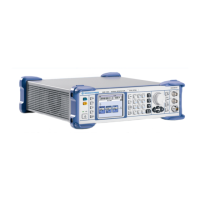R&S SMB Test Procedures
1407.0806.82 1.27 E-5
Output Impedance
Test assembly "Test Assembly for Output Impedance (VSWR)" (page 1.5)
Test method For the VSWR measurement of a source the effect of the level control
must be taken into account. For this purpose, an auxiliary generator is
used which transmits a wave with a slightly offset carrier frequency
into the DUT. The difference frequency hast to be within the control
b
andwidth of the level control. In the case of ideal source impedance,
the wave from the auxiliary generator is not reflected by the DUT. In
the case of not ideal DUT source impedance, the output wave of the
DUT and the reflected wave of the auxiliary generator are
superimposed on one another. A directional coupler couples a part of
these outgoing superimposed waves to an analyzer. The frequency
offset, results in a beat of the superimposed outgoing waves. The
VSWR is the ratio between the maximum and minimum amplitude of
the beat.
Measurement Settings on DUT:
- Level: test level
- Frequency: test frequency, unmodulated
Settings on spectrum analyzer:
- Test frequency, span 0 Hz, test level
- Resolution and video bandwidth 10 kHz
- Linear level scale
- Sweep time 20 ms
Settings on second signal generator:
- set the frequency to the test frequency – 100 Hz,
- set minimum level, unmodulated.
Vary the reference level to bring the line displayed on the screen of
the spectrum analyzer approximately into the middle of the screen.
Measure the voltage of the signal V
ref
.
Unscrew the VSWR bridge from the DUT and let the test port open.
Increase the level of the second signal generator until the voltage
on the analyzer is V
ref
± 0.5 %.
Screw the VSWR bridge onto the DUT again.
Measure the maximum voltage Vmax and minimum voltage Vmin
of the sinusoidal trace. Calculate the VSWR:
VSWR = Vmax/Vmin
Recommended test
frequencies and levels
Test frequencies: from 200 kHz every 50 MHz up to RF
max
.
Test levels: +2 dBm and +10 dBm.

